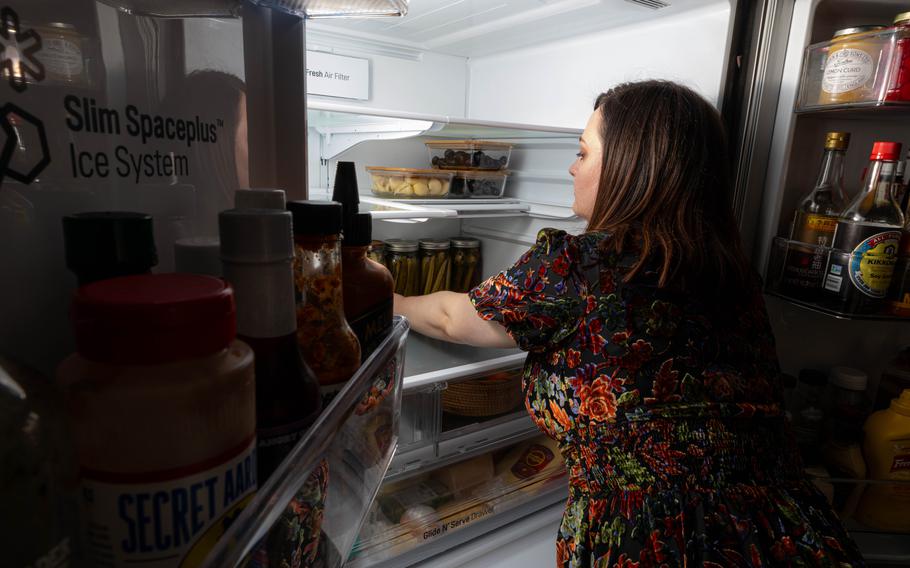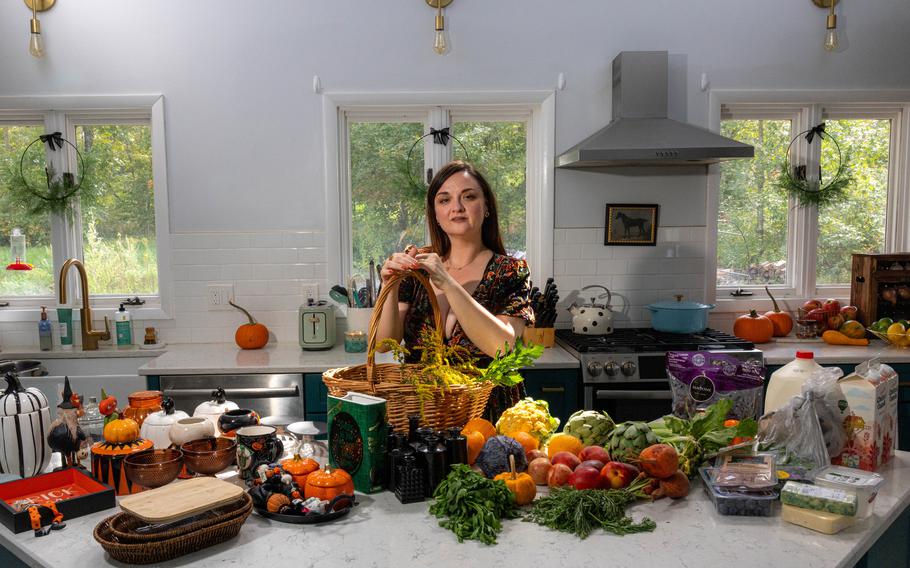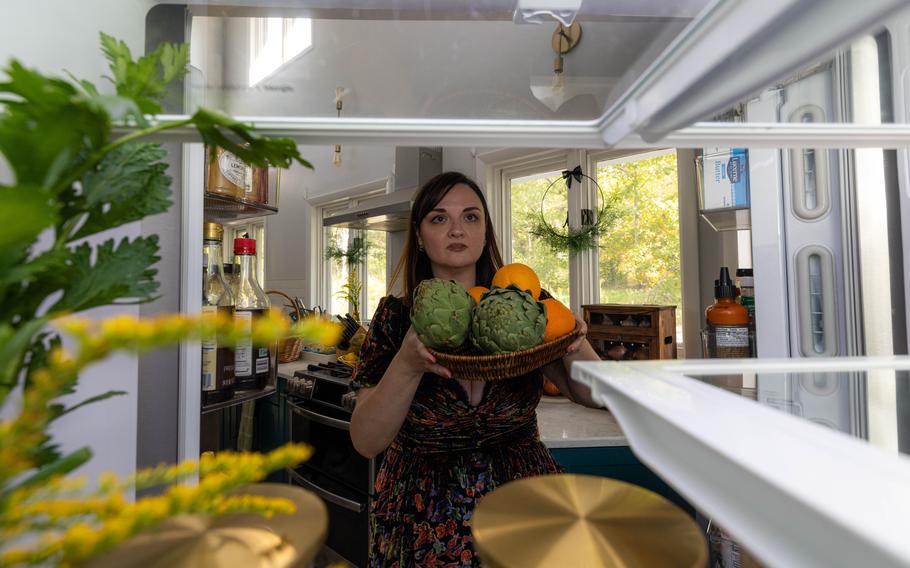
Lynzi Judish restocks her refrigerator with all the trappings. (Alex Kent/For The Washington Post)
Fridgescaping — making the inside of your refrigerator worthy of a star spot on your Instagram or TikTok feed — has been all over social media lately. Yes, it includes the obligatory color-coordinated items stored in clear containers, and condiments and beverages lined up in neat rows. But some people are taking it a step further. Think vases of flowers, fresh fruit in decorative bowls and framed photos perched on shelves.
It’s taking refrigerator organization to a whole new level.
“This is home decor meets home organization,” says Dawn Jackson Blatner, a registered dietitian nutritionist in Chicago and author of “The Superfood Swap.” “Fridgescaping is almost like the tablescaping vibe.”
Some even have themes, such as “The Hobbit” or “Bridgerton.” Creative, yes, but it raises the question: Is it practical? The answer is: It depends on how it’s done and whom you ask.

Lynzi Judish prepares produce and seasonal decor that she will put into her refrigerator. Her fridge will be Halloween-themed. (Alex Kent/For The Washington Post)
The perks of fridgescaping
“The great thing about the trend is it elevates caring for one of the more neglected areas of your home,” says Shira Gill, an organizing expert in the San Francisco Bay Area and author of “Minimalista.” “I like the intentionality and thoughtfulness behind it.”
On the upside, it may lead to cleaner refrigerators if you routinely wipe down the shelves and get rid of dirt, dust and crumbs that can cross-contaminate foods, Blatner says. And regularly taking inventory and tossing expired items will make it easier to access the foods you want. “If you make healthy foods look more enticing in the fridge, you’re more likely to eat at home,” Blatner says.
A clean, organized fridge also may reduce food waste because you can see and get your hands on items before they perish. This is important because research has found that people typically eat significantly less of the food they put in their refrigerators than they intend to — and end up discarding a lot of it.
For some people, fridgescaping is a creative outlet and a source of both pleasure and pride. Others say it has a calming, therapeutic effect.

Lynzi Judish places a bowl in her Halloween-themed fridge. (Alex Kent/For The Washington Post)
Potential drawbacks
But there are also potential food safety issues involved. For example, when highly perishable items (think dairy foods) are transferred to glass containers, there’s a risk of bacterial contamination. And the transfer could make the food spoil faster, says Mary Ellen Camire, a professor of food science and human nutrition at the University of Maine, Orono. “It’s also harder to keep track of use-by dates if you switch containers,” she says
Plus, when milk is stored in clear containers, the increased exposure to light could negatively affect the nutrients, especially riboflavin, Camire adds.
Other foods, such as berries, can be compromised when stored in uncovered baskets or bowls in the fridge. “Berries aren’t meant to be exposed to open air [in the fridge] — they dry out faster and lose vitamins,” Camire says. But don’t put them in sealed jars, either. That can lead to rapid mold growth. “If one starts to go, it makes it easier for the fungus to spread to other berries,” she adds.
Another thing to keep in mind: Not all decorative containers are safe for food storage. Beverages decanted into vintage crystal pitchers, or fruit in antique metal bowls, could absorb lead.
As for more decorative items, Camire says storing fresh flowers inside the fridge could bring in bugs that could get into your food. And Gill cautions that framed photos on fridge shelves could fall over and break. “The last thing you want in your fridge is broken glass,” she says.
It also takes considerable time and effort to maintain the pristine organization and presentation that fridgescaping entails.
“I think people who do this have a lot of time on their hands,” says Robyn Reynolds, a certified professional organizer based in the Los Angeles area. “Ultimately, the question is: Is it worth it for you to take the time to do it?”
It also may be impractical to opt for full-on fridgescaping, given that, in many households, multiple people are using the refrigerator, and they may not take the care to maintain your decorative scheme.

Lynzi Judish organizes containers that will hold some of her produce in her Halloween-themed fridge. (Alex Kent/For The Washington Post)
How to find a middle ground
Blatner is a fan of what she calls “fridgescaping lite,” a more practical approach that incorporates parts of the idea. On a weekly basis, empty the fridge, wipe down the shelves and toss expired items, she says.
Then, organize new items according to the FIFO method (“first in, first out”). Place newer items toward the back of the shelves and older ones near the front. This will set you up to use older items first. Gill also recommends having an eat-it-first basket in the fridge for perishable fruit and snacks.
To maintain an organized fridge, experts recommend creating designated zones for drinks, dairy products, fruits, vegetables, condiments, leftovers and other items. This type of system keeps the fridge looking organized and makes it easy to get your hands on healthy foods quickly.
“Put healthy foods such as fruits, veggies and healthy snacks at eye level,” Blatner says, so they’re easy to see and grab. Place raw meat and poultry on the bottom shelf of the fridge to prevent the juices from dripping onto other foods.
If you crave a uniform look inside your fridge, you can store sauces, dressings, cut-up fruits and veggies and leftovers or prepared foods in clear glass, airtight, stackable containers, with labels (include their storage or use-by dates).
“Fridgescaping lite could lead to a more welcoming, organized, healthier fridge,” Blatner says. This in turn could foster better eating habits for everyone in your household.